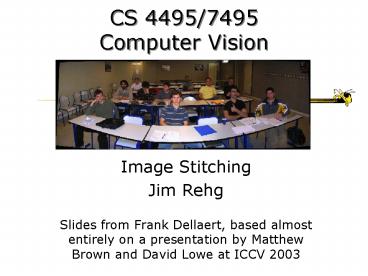CS 44957495 Computer Vision - PowerPoint PPT Presentation
1 / 39
Title:
CS 44957495 Computer Vision
Description:
Why 'Recognising Panoramas'? 1D Rotations (q) Ordering matching images ... Finding the panoramas. Bundle Adjustment. Multi-band Blending. Results. Conclusions ... – PowerPoint PPT presentation
Number of Views:33
Avg rating:3.0/5.0
Title: CS 44957495 Computer Vision
1
CS 4495/7495Computer Vision
- Image Stitching
- Jim Rehg
- Slides from Frank Dellaert, based almost entirely
on a presentation by Matthew Brown and David Lowe
at ICCV 2003
2
Introduction
- Are you getting the whole picture?
- Compact Camera FOV 50 x 35
3
Introduction
- Are you getting the whole picture?
- Compact Camera FOV 50 x 35
- Human FOV 200 x 135
4
Introduction
- Are you getting the whole picture?
- Compact Camera FOV 50 x 35
- Human FOV 200 x 135
- Panoramic Mosaic 360 x 180
5
Human FOV
www.inition.co.uk/ inition/guide_hmds_vrar.htm
6
Why Recognising Panoramas?
- 1D Rotations (q)
- Ordering ? matching images
7
Why Recognising Panoramas?
- 1D Rotations (q)
- Ordering ? matching images
8
Why Recognising Panoramas?
9
Why Recognising Panoramas?
10
Why Recognising Panoramas?
11
Overview
- Feature Matching
- SIFT Features
- Nearest Neighbour Matching
- Image Matching
- Bundle Adjustment
- Multi-band Blending
- Results
- Conclusions
12
Invariant Features
- Schmid Mohr 1997, Lowe 1999, Baumberg 2000,
Tuytelaars Van Gool 2000, Mikolajczyk Schmid
2001, Brown Lowe 2002, Matas et. al. 2002,
Schaffalitzky Zisserman 2002
13
SIFT Features
- Invariant Features
- Establish invariant frame
- Maxima/minima of scale-space DOG ? x, y, s
- Maximum of distribution of local gradients ? q
- Form descriptor vector
- Histogram of smoothed local gradients
- 128 dimensions
- SIFT features are
- Geometrically invariant to similarity transforms,
- some robustness to affine change
- Photometrically invariant to affine changes in
intensity
14
Overview
- Feature Matching
- SIFT Features
- Nearest Neighbour Matching
- Image Matching
- Bundle Adjustment
- Multi-band Blending
- Results
- Conclusions
15
Nearest Neighbour Matching
- Find k-NN for each feature
- k ? number of overlapping images (we use k 4)
- Use k-d tree
- k-d tree recursively bi-partitions data at mean
in the dimension of maximum variance - Approximate nearest neighbours found in O(nlogn)
16
Overview
- Feature Matching
- Image Matching
- RANSAC for Homography
- Bundle Adjustment
- Multi-band Blending
- Results
- Conclusions
17
RANSAC for Homography
18
RANSAC for Homography
19
RANSAC for Homography
20
Overview
- Feature Matching
- Image Matching
- RANSAC for Homography
- Finding the panoramas
- Bundle Adjustment
- Multi-band Blending
- Results
- Conclusions
21
Finding the panoramas
22
Finding the panoramas
23
Finding the panoramas
24
Finding the panoramas
25
Overview
- Feature Matching
- Image Matching
- Bundle Adjustment
- Error function
- Multi-band Blending
- Results
- Conclusions
26
Error function
- Sum of squared projection errors
- n images
- I(i) set of image matches to image i
- F(i, j) set of feature matches between images
i,j - rijk residual of kth feature match between
images i,j - Robust error function
27
Homography for Rotation
- Parameterise each camera by rotation and focal
length - This gives pairwise homographies
28
Bundle Adjustment
- New images initialised with rotation, focal
length of best matching image
29
Bundle Adjustment
- New images initialised with rotation, focal
length of best matching image
30
Overview
- Feature Matching
- Image Matching
- Bundle Adjustment
- Warping
- Results
- Conclusions
31
Warping
- Take Notes
- Key
- iterate in target image
- calculate corresponding source pixel
- resample
- nearest neighbor (bad)
- bilinear (better)
- bicubic (best)
32
Overview
- Feature Matching
- Image Matching
- Bundle Adjustment
- Multi-band Blending
- Results
- Conclusions
33
Multi-band Blending
- Burt Adelson 1983
- Blend frequency bands over range ? l
34
2-band Blending
Low frequency (l gt 2 pixels)
High frequency (l lt 2 pixels)
35
Linear Blending
36
2-band Blending
37
Overview
- Feature Matching
- Image Matching
- Bundle Adjustment
- Multi-band Blending
- Results
- Conclusions
38
Results
39
Results
http//www.cs.ubc.ca/mbrown/panorama/panorama.ht
ml Autopano based on UBCs code live demo































